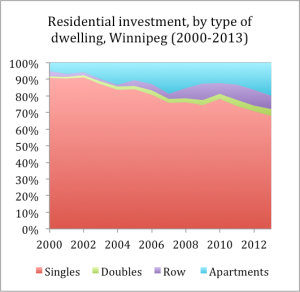By Josh Brandon
Manitoba cities inched towards higher density with more apartments and fewer single families homes built in 2013. Growth in multi-unit residential construction should provide some relief on the critically low vacancy rates Manitoba cities have seen in recent years. However, much of the investment is in higher end rental or in condominiums and continues to exclude lower income households. Ongoing support for affordable and social housing will be needed to ensure that units are available to low-income families in Manitoba.
For the first time since 2000, more than 30 per cent of new residential construction was in multi-unit developments, with single-family homes making up 68 per cent of new investments. By contrast, over 90 per cent of new construction was in single-family dwellings in 2000. Apartments (including both rental and condos) in 2013 made up 20 per cent of new construction, compared to 5 per cent in 2000.
Source: Statistics Canada. Table 026-0013 – Residential values, by type of investment, annual (dollars), CANSIM (database).
Partly as a result of these new investments, vacancy rates in Manitoba cities rose in 2013, reaching 2.5 per cent in Winnipeg – the highest level since 1999. A recent report by Downtown Winnipeg Market Research shows over 1800 residential units built downtown since 2005. Many of these investments (about one fifth of new downtown units) have included provincially funded affordable housing or social housing components. This demonstrates the important role that government can play in shaping the private market. Nonetheless, the total stock of purpose built rental units in Winnipeg has not regained its losses from earlier in the decade and affordable housing remains inaccessible for many. With only 6.6 units per 100 residents, the private rental market has declined substantially compared to its relative size in 1992. Moreover, the higher vacancy rates are still skewed by higher availability for luxury and high cost apartments in Winnipeg. The vacancy rate for apartments renting at over $1140 per month was 6.8 per cent in 2013.
Source: CMHC Winnipeg Rental Market Report (various years).
Gradually, Winnipeg’s housing market is making a shift towards more urban development. Provincial investments have been a significant factor in that shift. In 2009, the Provincial government committed to build 1500 units of affordable housing along with creating 1500 units of social housing (Rent Geared to Income) by 2014. In last year’s budget they extended those commitments by promising 500 further units of each over the next three years. These data do not yet reflect the new Provincial Rental Housing Construction Tax Credit which should give a further boost to rental construction and affordable housing in the next few years. These investments are critical for ensuring that investments in new construction reach families most in need. Meanwhile, Manitoba is slowly catching up to the rest of the country in the trend towards multi-unit construction.
Josh Brandon is Housing and Community Development Researcher with CCPA-MB





Josh thank you for pulling together this data and presenting it in such a clear, succinct manner. Much appreciated! Cathy Campbell